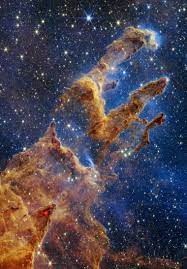James Webb Telescope : Pillars Of Creation

Highly detailed landscape- the iconic “Pillars of Creation” has been caught by NASA’s powerful James Webb Telescope.
Pillars of Creation:
- It is a vista of three looming towers made of interstellar dust and gas.
- These iconic Pillars of Creation is located in the centre of the Eagle Nebula (it is a constellation of stars), which is also known as Messier 16.
- The images show vast, towering columns of dense clouds of gas and dust where young stars are forming in a region some 6,500 light-years from Earth.
- At the ends of several pillars are bright red, lava-like spots. These are ejections from stars that are still forming, only a few hundred thousand years old.
- The pillars were made famous by the Hubble Space Telescope, which first captured them in 1995 and then again in 2014.
- The new image will help researchers revamp their models of star formation by identifying far more precise counts of newly formed stars, along with the quantities of gas and dust in the region.
James Webb Space Telescope:
- The telescope is the result of an international collaboration between NASA, the European Space Agency (ESA) and the Canadian Space Agency which was launched in December 2021.
- It is currently at a point in space known as the Sun-Earth L2 Lagrange point, approximately 1.5 million km beyond Earth’s orbit around the Sun.
- Lagrange Point 2 is one of the five points in the orbital plane of the Earth-Sun system.
- Named after Italian-French mathematician Josephy-Louis Lagrange, the points are in any revolving two-body system like Earth and Sun, marking where the gravitational forces of the two large bodies cancel each other out.
- Objects placed at these positions are relatively stable and require minimal external energy or fuel to keep themselves there, and so many instruments are positioned here.
- It’s the largest, most powerful infrared space telescope ever built.
- It’s the successor to Hubble Telescope.
- It can see backwards in time to just after the Big Bang by looking for galaxies that are so far away that the light has taken many billions of years to get from those galaxies to our telescopes




